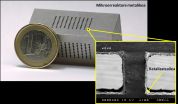(Press-News.org) Familiar voices can improve spoken language processing among school-age children, according to a study by NYU's Steinhardt School of Culture, Education, and Human Development. However, the advantage of hearing a familiar voice only helps children to process and understand words they already know well, not new words that aren't in their vocabularies.
The findings, which were published online in August in the Journal of Child Language, suggest that children store information about a speaker to retrieve and harness at a later time, similar to what has been found for adult listeners.
Research has shown that when adults are familiar with someone's voice, they can more accurately – and even more quickly – process and understand what the person is saying. This concept, known as the familiar talker advantage, comes into play in situations where it is difficult to hear. For example, in a loud or crowded room, adults can better understand those whose voices they already know.
However, little research has been done in children to see how they process familiar versus unfamiliar voices. Children are still acquiring language and their skills are less honed than adults, yet they are more adversely affected by background noise. If children also experience an advantage when hearing familiar voices, it is possible that the improvement in language processing could free up cognitive resources for other tasks.
"Most adults are good at adapting to the way people speak," says Susannah Levi, assistant professor of communicative sciences and disorders at NYU Steinhardt and the study's author. "It's helpful to know that adults have an advantage with familiar speakers, because if you learn how a person talks, you can use that information to your benefit. We were interested in seeing if and when the advantage develops in children."
The current study explored whether the familiar talker advantage is found in children ages seven to 12. Forty-one children participated in the study, first listening to a series of words and repeating them to give researchers a baseline for how accurately each child identified words.
The children then spent five days learning the voices of three German-English bilingual speakers, represented by cartoon characters in a computer program. The characters spoke a series of single words, and the children learned to identify the characters by their voices.
Finally, the children completed tasks in which they heard words spoken by six German-English bilingual speakers, and were asked to repeat the words. Three of the six speakers were the voices of the characters they had already learned.
Half of the words used in the task were common words children would likely know and use (such as cat, book, and hug), and half were less familiar or even unknown (such as loathe, sage, and void). The study used recordings of bilingual speakers to allow the researchers to test whether children acclimated to the speakers' accents.
The study revealed that children could more accurately repeat the words spoken by familiar voices, demonstrating that their spoken language processing improved with familiar speakers. However, this improvement was limited to the words children were likely to know, and the familiarity was not useful for words they didn't know.
"It didn't matter who the children heard speak an unfamiliar word – a familiar voice or a stranger – because they were just as likely or unlikely to understand what was said," says Levi.
Children with the poorest performance at the baseline testing showed the greatest benefit of hearing familiar speakers. In addition, despite learning three voices with German accents, the accents did not provide an advantage to the children when they heard unfamiliar German-accented voices.
Levi noted that the findings may have implications for children learning in environments with background noise.
"Adults and children can process language really well in quiet environments or with headphones on. But most of life, including classroom learning, is done in environments that aren't silent," Levi says. "This study shows that children were able to integrate knowledge of what a person sounds like and use this to their advantage. A potential benefit is that when there's background noise and kids are listening to a familiar voice, like a teacher's, kids use the familiarity to their advantage."
INFORMATION:
This work was supported by a grant from the National Institute on Deafness and Other Communication Disorders, part of the National Institutes of Health (1R03DC009851-01A2).
About the Steinhardt School of Culture, Education, and Human Development (@nyusteinhardt)
Located in the heart of Greenwich Village, NYU's Steinhardt School of Culture, Education, and Human Development prepares students for careers in the arts, education, health, media, and psychology. Since its founding in 1890, the Steinhardt School's mission has been to expand human capacity through public service, global collaboration, research, scholarship, and practice. To learn more about NYU Steinhardt, visit steinhardt.nyu.edu.
Children understand familiar voices better than those of strangers
2014-10-06
ELSE PRESS RELEASES FROM THIS DATE:
School connectedness can help bullied gay and bisexual youth
2014-10-06
In a study of 951 lesbian, gay, and bisexual youth, those experiencing both cyber and school bullying were most likely to engage in aggressive and suicidal behaviors. However, bullied youth who felt connected to an adult at school were not more likely to report such behaviors.
"In recent years, clubs such as Gay-Straight Alliances have played an integral role in creating safer environments in schools. These efforts are often student-led with the guidance of only a handful of adult advisors; however, our study highlights just how important adults are in buffering sexual ...
Stigma can hinder access to health care for the poor
2014-10-06
In a study of 574 low-income adults, many felt stigmatized when receiving medical care. This stigma was most often the result of interactions with clinicians that felt demeaning, rather than an internalized sense of shame related to receiving public insurance or charity care.
Experiencing stigma was associated with unmet health needs, poorer perceptions of quality of care, and worse self-reported health.
"Feeling judged by providers was associated with higher reports of unmet physical and mental health needs and declining health, even though people who reported stigma ...
Observing the Birkeland currents
2014-10-06
When the supersonic solar wind hits the Earth's magnetic field, a powerful electrical connection occurs with Earth's field, generating millions of amperes of current that drive the dazzling auroras. These so-called Birkeland currents connect the ionosphere to the magnetosphere and channel solar wind energy to Earth's uppermost atmosphere. Solar storms release torrential blasts of solar wind that cause much stronger currents and can overload power grids and disrupt communications and navigation.
Now for the first time, scientists are making continuous, global measurements ...
Through the combining glass
2014-10-06
Trying on clothes when a shop is closed could become a reality thanks to new research that uses semi-transparent mirrors in interactive systems and which will be unveiled at an international conference tomorrow [Tuesday 7 October].
The research paper, to be presented at one of the world's most important conferences on human-computer interfaces - ACM UIST 2014 [5-8 October], could change the way people interact and collaborate in public spaces, such as museums and shop windows.
The research, led by Professor Sriram Subramanian, Dr Diego Martinez Plasencia and Florent ...
Study: Workplace diversity can help the bottom line
2014-10-06
Gender diversity in the workplace helps firms be more productive, according to a new study co-authored by an MIT researcher — but it may also reduce satisfaction among employees.
"Having a more diverse set of employees means you have a more diverse set of skills," says Sara Ellison, an MIT economist, which "could result in an office that functions better."
At the same time, individual employees may prefer less diverse settings. The study, analyzing a large white-collar U.S. firm, examined how much "social capital" offices build up in the form of things like cooperation, ...
New imaging technique could detect acoustically 'invisible' cracks
2014-10-06
The next generation of aircraft could be thinner and lighter thanks to the development of a new imaging technique that could detect damage previously invisible to acoustic imaging systems.
The nonlinear acoustic technique developed by researchers from the University of Bristol's Ultrasonics and Non-destructive Testing (NDT) research group is published in the current issue of Physical Review Letters together with an accompanying article in Physics.
It has long been understood that acoustic nonlinearity is sensitive to many physical properties including material microstructure ...
A novel roadmap through bacterial genomes leads the way to new drug discovery
2014-10-06
For millennia, bacteria and other microbes have engaged in intense battles of chemical warfare, attempting to edge each other out of comfortable ecological niches. Doctors fight pathogens with an arsenal of weapons—antibiotics—co-opted from these microbial wars, but their efforts are frustrated by the development of drug resistance that outpaces drug discovery. Researchers at the University of Illinois at Urbana-Champaign and Northwestern University have now innovated and demonstrated the value of an algorithm to analyze microbial genomic data and speed discovery of new ...
Improvements in fuel cell design
2014-10-06
This news release is available in Spanish.
Fuel cells are totally appropriate systems for substituting the batteries of mobile phones, laptop computers and vehicles. They turn the energy resulting from the combining of hydrogen and oxygen into electrical power, with water vapour being the only waste product. In other words, they generate energy in the same way that batteries do, but they do not contaminate.
However, if these fuel cells are to produce energy, they need an external supply of hydrogen, and right now storing hydrogen safely poses difficulties. That ...
Mother's behavior has strong effect on cocaine-exposed children
2014-10-06
BUFFALO, N.Y. – It is not only prenatal drug exposure, but also conditions related to drug use that can influence negative behavior in children, according to a new study from the University at Buffalo's Research Institute on Addictions.
In examining the long-term effects of cocaine use during pregnancy in a sample of low-income, cocaine-exposed and non-exposed families, researchers found that a mother's harshness toward her child during mother-child interactions at 2 years of age is one of the strongest predictors of problem behaviors in kindergarten, such as fighting, ...
Are Montana's invasive fish in for a shock?
2014-10-06
A new paper from the Wildlife Conservation Society, Montana State University, Montana Department of Fish, Wildlife and Parks, and the U.S. Geological Survey looks at the feasibility of electrofishing to selectively remove invasive trout species from Montana streams as an alternative to using fish toxicants known as piscicides that effect all gill-breathing organisms.
Westslope Cutthroat Trout (WCT) have experienced severe declines throughout much of their historical range. One major reason for this decline is the current competitive advantages enjoyed by non-native Brook ...

